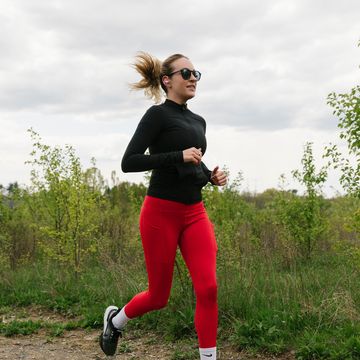Anyone can train for and run a half marathon. The distance is substantial enough to require a strategy, but with the right training and support, the goal is absolutely achievable—with plenty of room for smiles at the finish line.
To maximize the fun factor, Runner’s World partnered with the happiest place on earth, Walt Disney World Resort, to offer five RW+ members an opportunity to train alongside RW editors and race the 2025 Disney Princess Half Marathon. For 10 weeks, these members had access to exclusive training content, got personalized answers to all their questions, and fine-tuned their fitness so they could show up confident on race day. Here are the game-changing lessons they learned on the way to their most fun 13.1.
"I wanted to make sure I could keep running for the long term, and strength training seemed crucial, even if it’s not my favorite thing."
David Berman | 49 | New York City
David set out to conquer 13.1 miles during the pandemic, giving himself an achievable goal to work toward that would also support his mental health. But he injured his IT band while training for his first half marathon in 2023 and had to postpone until 2024. In the process, he fell in love with longer distances and now hopes to extend his training to a full marathon later in 2025.
Since then, David has been diligent about staying injury-free. “I knew about strength training in the abstract, but I really learned about it the hard way.” During the training cycle, David focused on figuring out how to best incorporate strength training into his week and used RW’s guided exercise videos tailored to runners. “It helped me feel more confident I was doing the movements correctly.” Although he struggled with mild muscle pain during the last 2 miles of the Disney Half, he crossed the line feeling strong. “As soon as I finished, the pain went away,” he says. “The strength training helped.”
We Got You!
Rule #1: No Max Efforts on Leg Day
There’s a reason you should do strength training in addition to running: Practicing both forms of exercise helps you build stronger muscles and increase your aerobic capacity at the same time. The key is to create a strength-training schedule that optimally fits into your run training.
And specifically, don’t plan hard efforts on the same day you do lower-body work like squats, deadlifts, and lunges. Running at maximal effort is impaired 24 hours after lower-extremity resistance training, says Kenji Doma, PhD, a sports and exercise scientist at James Cook University in Queensland, Australia.
Doma found that running performance at lower intensities was unaffected by weight workouts. “Runners could undertake strength training and running sessions on the same day six hours apart, as long as the running session is set at submaximal intensities.” If you have an easy, long, or recovery run on the schedule, you can safely double up that day—as long as you keep them the prescribed six hours apart. On days when you run and lift, Doma suggests you get the run in first.—Scott Douglas and Dan Roe
Sample Weekly Schedule
- Day 1: Light resistance training with a focus on upper body
- Day 2: Tempo run
- Day 3: Easy run in the morning; heavy resistance training with a focus on lower body in the evening
- Day 4: Off
- Day 5: Tempo run
- Day 6: Easy run
- Day 7: Long run
"A warmup is something I had never done, and it’s really improved my running."
Bill Stewart | 56 | Beverly, Massachusetts
Bill began running about a year ago, after an annual checkup. At that time, he weighed over 300 pounds and had just been diagnosed with type 2 diabetes. He started with daily walks, then progressed to running and quickly lost 80 pounds, reversing his diagnosis. In 12 weeks, he run/walked his first 5K, making his way up to a half marathon a few months later.
During his first half-marathon training, he had made a few mistakes he was hoping not to repeat. “I used to start feeling discomfort in my left calf early into my runs,” he says. “I realized I never actually felt good during that first mile.” Bill experimented with various dynamic routines recommended by RW editors, then zeroed in on the moves that felt best for his body. During the race, everything went according to plan. “The difference has been night and day,” he says. “My body felt more prepared, and I settled into my pace much more comfortably.”
We Got You!
Your Simple Warmup Strategy
Without properly warming up your body, you increase the risk of pulling a muscle, injuring a tendon or joint, or worse. You could end up slowing down and burning out before you’re done with your workout, likely finishing your run feeling exhausted, discouraged, and dreading the next one.
A smart running warmup gives your muscles, bones, and joints a chance to loosen up; it gradually and gently brings up your heart rate, and makes it easier to get into the rhythm you want to sustain so you can run—and finish—feeling exhilarated and energized. One study in the Journal of Strength and Conditioning Research showed that when runners performed a dynamic stretching routine before a treadmill workout, they were able to run longer during a hard effort compared to those who hadn’t.
A warmup doesn’t have to be complicated. Choose three to five dynamic stretches like jumping jacks, lunges, and squats, and do each for 30 seconds. Cycle through the sequence two to three times. Find suggestions at runnersworldblog.com/warmups.—Jennifer Van Allen and Jordan Smith
“There’s no shame if you run/walk a race.”
Tracy McGriff | 60 | Summerville, South Carolina
Tracy has always run casually, especially while she served as a lieutenant colonel in the New Jersey Air National Guard and as a police sergeant. After she retired in 2018, she added racing to support her weight loss journey. “I was hesitant to do longer runs because I felt like I’m not a big runner,” she says. She has slowly worked her way up to 10Ks, and when she heard about the chance to train with RW for the Disney Half Marathon, she decided to take on the challenge and double the distance.
During the training, Tracy built up her confidence by testing various run/walk interval ratios recommended by RW experts. “I had a lot of previous injuries and I’m older, so I try to take it easy, but I want to enjoy my run,” she says. “The run/walk method opens up a plethora of racing opportunities for me.” After successfully finishing the race, Tracy is now on her way to reaching her ultimate goal: running a marathon at the age of 60.
We Got You!
How to Plan a Run/Walk Race
These days many runners recognize that walking breaks can be a strength—they give your legs and heart a chance to recover so you can push harder when you run. Your run intervals may become even faster than your usual pace, which can improve your overall race times. During a walk, briefly catch your breath without losing your sense of forward motion.
Many big races have run/walk pacing groups with a pace leader who signals the beginning and end of each interval. For example, at the Disney Princess Half, one group runs 4 minutes and walks 30 seconds, aiming to finish in 1:45 (equivalent to an 8-minute-mile pace), while other groups run 15 seconds and walk 30 seconds to finish the same race somewhere between 3:10 and 3:30 (equivalent to anywhere between a 14:29-minute pace and a 16-minute pace).—Donna Raskin
“I still have a few PR goals, but I’m excited to add more just-for-fun races to the calendar.”
Ashlee Whitmire | 34 | Twentynine Palms, California
After 15 years of running, Ashlee would sometimes find it hard to stay motivated. For the active-duty spouse whose family moves a lot, running is one of the few constants in her life, helping her get acquainted and grounded wherever her new home is. It has also supported her through anxiety, depression, and the loss of a family member.
Ashlee spends a lot of time caring for others, so to do something for herself for a change, she signed up to race with Runner’s World. “For a lot longer than I want to admit, I’ve been thinking about my next PR, the end of a run or race, and not all the in-between, which is supposed to be the best part,” she says. During this training block, she focused on how to make running fun again. “I sent my best friend videos, which kept my pace slower and my runs more enjoyable. When I saw people I knew while running, I stopped and talked instead of just giving a wave. I basically took the pressure off and trusted that my body and I know what we’re doing.” Ashlee is in the process of running a half marathon in every state, and slowing down during the Disney Half helped her recognize how much of the surroundings she had missed at other races. “It made me realize I had taken the fun out of running. I learned things, and it just made me fall in love with running even more.”
We Got You!
Benefits of the I’m-Not-Racing
Race Races can offer the satisfaction of fast times and new records, but you don’t have to sign up just to get speedier. Here’s why you should participate in a race without actually racing it.
- It helps you stay consistent. You can find purpose in competing against others or yourself, but you also gain major payoffs from training for a race just by staying consistent with your runs.
- It gives you fresh eyes. Running through a neighborhood closed to traffic feels completely different and new, often allowing you to reach parts of town that don’t have regular pedestrian access. This lets you see a familiar city from a new perspective or explore a whole new area with a deeper appreciation.
- It boosts your social connections. Sharing a training block and crossing the finish line hand-in-hand with loved ones can bring more meaning to the miles. It gives you a goal to work toward together, provides time to catch up, and offers one-on-one time with your favorite people.
- It can reset your relationship with running. Being surrounded by like-minded people and having spectators cheer you on from start to finish can remind you that just moving your body—no matter the speed—can seriously boost your mood.
- It teaches you more about yourself. No race (or training block) is ever the same, even if you’re running the same course. Neither are the lessons you pick up along the way. So why not give yourself more opportunities to get on the starting line and see what more you can learn?—Mallory Creveling
“I didn’t expect everyone to be so helpful—the group was just ready to enjoy the experience.”
Chantal Alison-Konteh | 34 | New York City
Chantal became a wife and a mom of three early in life and spends a lot of time supporting her community through nonprofit service. Running is the one thing she does for herself. She finds peace in running; it helps her manage anxiety and reclaim a sense of self in her busy household.
Chantal found the group training—even when virtual—helpful for accountability and normalizing her experiences. When she and another participant, David, got snowed in during training, Chantal was worried about doing her long run on the treadmill or altering her training plan. “He said, ‘I’m here right with you, it’s way too icy out there to be running,’ and we were able to navigate that process together.” She enjoyed the recurring check-ins and getting answers to all her questions. “It was nice…getting nutrition recommendations and even just listening to how other people’s training is going. As I train to run the NYC marathon in November, I’d love to join a run club—if I can find one with a similar joy vibe!”
We Got You!
Find the Right Run Club
Studies show that runners who are part of a group or a club feel supported both during and outside of the run, and participants also report creating meaningful friendships within the larger running group. Here are some questions you can ask to find out if a club is a good fit for you.
- What type of runners does the club have?
- What are their pace groups or drop policies?
- What days and how many times a week do they meet? Where and at what time?
- Are you able to join for a trial run?
- How long are the runs?
- Is there parking and a safe place to leave valuables like keys or your workout bag?
- Is there a place to change before and after the run?
- Is there water available on the route or afterward, or do runners carry their own?
- Are bathrooms available?
- Are directions or maps given out for the run routes?—Susan Paul
Make a half marathon your next—and most fun—race with these programs available exclusively to Runner’s World+ members.
This holistic training program provides all the tools you need to navigate the entire half-marathon training journey—from building your base to how to run your race strategically.
Every member is eligible to sign up for a chance to enter select races, like the Disney Princess Half Marathon, New York City Marathon, Marine Corps Marathon, the Boulderthon Half, and more to come! We’re looking for runners from all backgrounds and a variety of skill levels. Save this page to stay updated on our latest race offerings!























